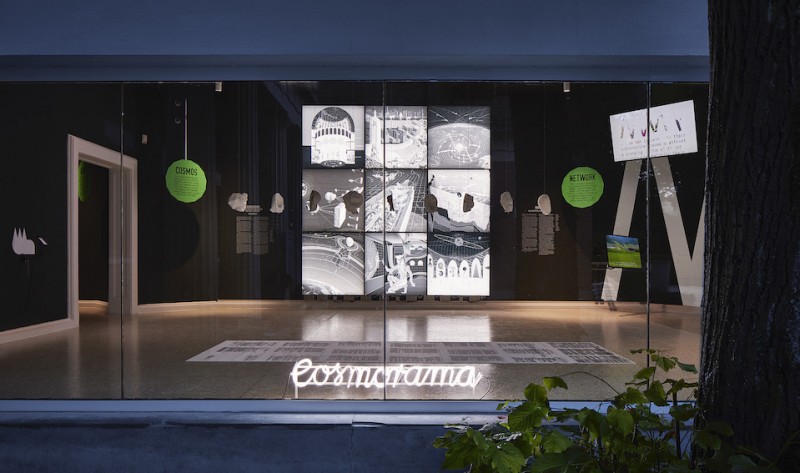Cosmorama
United States Pavilion at the Venice Architecture Biennale, Dimensions of Citizenship, 2018
Project Team:
El Hadi Jazairy + Rania Ghosn
Reid Fellenbaum, Jia Jane Weng, Kelly Koh, Shuya Xu, Monica Hutton, Rawan Al-Saffar, Lex Agnew, Garine Boghossian, Ranu Singh, Tianwei Yen, Sihao Xiong
Venue: Padiglione Stati Uniti, Giardini di Castello, 30122 Venezia, Italy
On View:
May 26 - November 25, 2018
Curated by:
Mimi Zeiger, Ann Lui, Niall Atkinson, Iker Gil
Advisor:
Benjamin Weiss, MIT EAPS
Iron Meteorite Loan:
The Meteorological Collection of the Harvard Mineralogical & Geological Museum
Photography:
Tom Harris
Cosmorama responds to current issues that shape humanity’s relationship to the cosmos in three geostories: “Mining the Sky,” “Planetary Ark,” and “Pacific Cemetery.” These geographic fictions render visible important matters unaccounted for in the technological triumphalism and frontier narratives of the Space Age. They project some of humanity’s present environmental and political hopes and fears, and bring forth these same systems and their attributes as generators of a renewed planetary imagination.
“Mining the Sky” speculates on the landscapes of the 2015 SPACE Act (Spurring Private Aerospace Competitiveness and Entrepreneurship Act) that recognized the right of US citizens to engage in the exploitation of extraplanetary resources, arguably in violation of the 1967 Outer Space Treaty that prevents any state from exercising “national appropriation by claim of sovereignty, by means of use or occupation, or by any other means.” This new franchising of outer space is expected to accelerate the nascent NewSpace entrepreneurial movement as companies such as Planetary Resources plan to extract billions of dollars worth of ore from near-Earth asteroids. The captured asteroids will be de-spun and towed to a mining depot at the Earth-Moon L1 Lagrange, a position where the combined gravitational pulls from the two celestial objects constitute a stable equilibrium point. Robotic arms process the asteroid. They either hollow out the asteroid collecting the trail of debris in the fabricated cave or mine the surface to carve out the face of the gods of the new space age. The mining station serves human settlements through the Interplanetary Transport Network, requiring minimal energy for an object to travel through such gravitationally determined highways through the solar system. The extraction stations constitute the first artificial constellation visible to human eye from Earth.
“Planetary Ark” is a collection of living animals that were launched into space on scientific missions to test the survivability of spaceflight for the human body, as well as other species currently threatened by the sixth mass extinction in Earth’s history. Now that climate change and uncertain futures define a new normal on Earth, animal species at (or past) the brink of extinction are sent out, each in its cubicle, on an ark to the International Space Station. Once funding for the most expensive structure ever built is discontinued in 2024, the International Space Station is repurposed into a microcosm of scientific experiments on forms of life, what it means to be human, and the making of worlds. It is also a place of last refuge, where some scientists can tend to creatures with remarkable care, in spite of their imminent disappearance. A few thousand years later, the offspring of these “fellow travelers” embark on a journey to resettle the Earth.
“Pacific Cemetery” is a vortex spiral island where decommissioned satellites and other space debris are brought back from orbit and recycled at Point Nemo in the Pacific Ocean. Over the next decades, thousands of satellites will be launched into space and eventually decommissioned after fifteen years of operation. Building on the precedent of the Pacific Proving Grounds, in which the United States secured an agreement with the United Nations to conduct nuclear testing at sites in the Pacific Ocean between 1946 and 1962, the US designates Point Nemo as the Strategic Trust Territory of the Space Age. At more than 1,400 nautical miles from the nearest land, Point Nemo is already the cemetery of de-orbited spacecraft, such as the Soviet-era MIR space station, the Jules Verne ATV and other European Space Agency cargo ships, and a SpaceX rocket. Also dubbed the Oceanic Point of Inaccessibility, Point Nemo is the landfill of the Space Age. It is a planetary terraforming project, in which the vestiges of space objects are recycled into bits of sovereignty to house climate refugees from Pacific Islands. The strategic area directive also proclaims that the United States would promote the economic advancement, self-sufficiency, and right to self-determination of such planetary refugees against the disappearance of their lands.
Project Details:
Nine 115x115 cm backlit drawings
Eight 3D printed heads
Meteorite from the Harvard Mineralogical & Geological Museum
Printed Carpet 120x420 cm
Cosmorama neon sign
Click for more information about the Cosmorama project.
